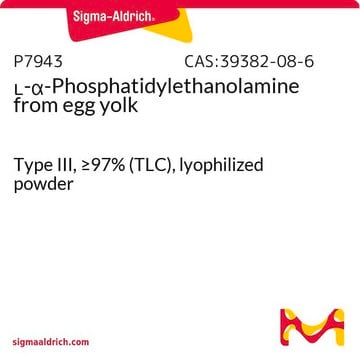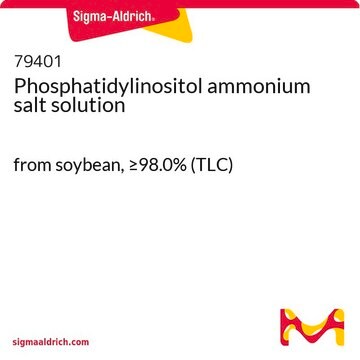P7769
1,2-Diacyl-sn-glycero-3-phospho-L-serine
from bovine brain, ≥97% (TLC), amorphous powder, structural phospholipid
Synonym(s):
3-sn-Phosphatidyl-L-serine, L-α-Phosphatidyl-L-serine, PS, Phosphatidylserine
About This Item
Recommended Products
product name
1,2-Diacyl-sn-glycero-3-phospho-L-serine, ≥97% (TLC), from bovine brain, amorphous powder
biological source
bovine brain
Assay
≥97% (TLC)
form
amorphous powder
storage temp.
−20°C
Looking for similar products? Visit Product Comparison Guide
Application
- as a lipid standard in time-of-flight secondary ion mass spectrometry (ToF-SIMS) spectral fingerprints
- as a reference standard in thin layer chromatography (TLC) for quantifying lipids from astrocyte-conditioned media (ACM) treated fibroblasts
- as a component of large unilamellar vesicles for annexin A2 aggregation studies
Biochem/physiol Actions
Features and Benefits
Caution
Storage Class Code
11 - Combustible Solids
WGK
WGK 3
Flash Point(F)
Not applicable
Flash Point(C)
Not applicable
Personal Protective Equipment
Certificates of Analysis (COA)
Search for Certificates of Analysis (COA) by entering the products Lot/Batch Number. Lot and Batch Numbers can be found on a product’s label following the words ‘Lot’ or ‘Batch’.
Already Own This Product?
Find documentation for the products that you have recently purchased in the Document Library.
Customers Also Viewed
Articles
Discover Bioactive Small Molecules for Lipid Signaling Research
Our team of scientists has experience in all areas of research including Life Science, Material Science, Chemical Synthesis, Chromatography, Analytical and many others.
Contact Technical Service











